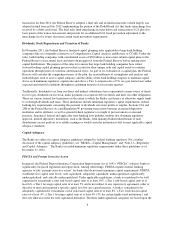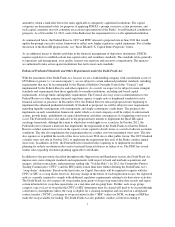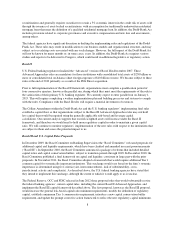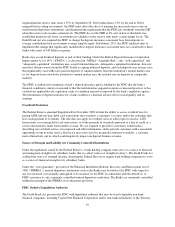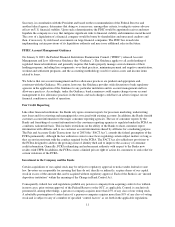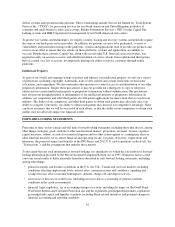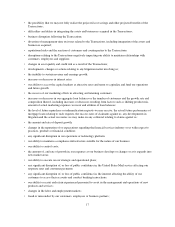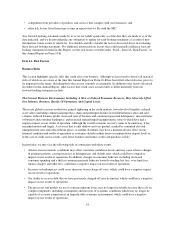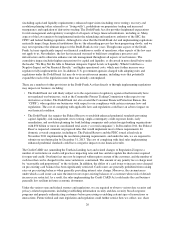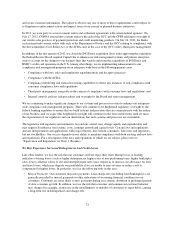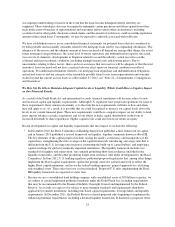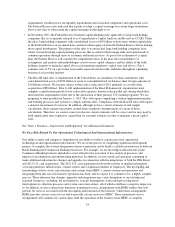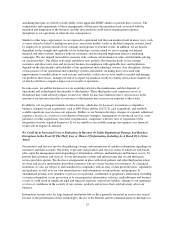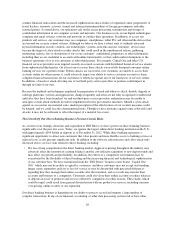Capital One 2012 Annual Report Download - page 35
Download and view the complete annual report
Please find page 35 of the 2012 Capital One annual report below. You can navigate through the pages in the report by either clicking on the pages listed below, or by using the keyword search tool below to find specific information within the annual report.
deliver systems and operational infrastructure. These relationships include (but are not limited to): Total System
Services Inc. (“TSYS”) for processing services for our North American and United Kingdom portfolios of
consumer and small business credit card accounts, Fidelity Information Services (“FIS”) for the Capital One
banking systems and IBM Corporation for management of our North American data centers.
To protect our systems and technologies, we employ security, backup and recovery systems and generally require
the same of our third-party service providers. In addition, we perform, or cause to be performed, a variety of
vulnerability and penetration testing on the platforms, systems and applications used to provide our products and
services in an effort to ensure that any attacks on these platforms, systems and applications are unlikely to
succeed. Despite these controls, Capital One, along with several other U.S. financial services providers, was
targeted recently on several occasions with distributed denial-of-service attacks from sophisticated third parties
that succeeded, on a few occasions, in temporarily limiting our ability to service customers through online
platforms.
Intellectual Property
As part of our overall and ongoing strategy to protect and enhance our intellectual property, we rely on a variety
of protections, including copyrights, trademarks, trade secrets, patents and certain restrictions on disclosure,
solicitation, and competition. We also undertake other measures to control access to and distribution of our other
proprietary information. Despite these precautions, it may be possible for a third party to copy or otherwise
obtain and use certain intellectual property or proprietary information without authorization. Our precautions
may not prevent misappropriation or infringement of our intellectual property or proprietary information. In
addition, our competitors and other third parties also file patent applications for innovations that are used in our
industry. The ability of our competitors and other third parties to obtain such patents may adversely affect our
ability to compete. Conversely, our ability to obtain such patents may increase our competitive advantage. There
can be no assurance that we will be successful in such efforts, or that the ability of our competitors to obtain such
patents may not adversely impact our financial results.
FORWARD-LOOKING STATEMENTS
From time to time, we have made and will make forward-looking statements, including those that discuss, among
other things, strategies, goals, outlook or other non-historical matters; projections, revenues, income, expenses,
capital measures, returns, accruals for claims in litigation and for other claims against us; earnings per share or
other financial measures for us; future financial and operating results; our plans, objectives, expectations and
intentions; the projected impact and benefits of the ING Direct and 2012 U.S. card acquisitions (collectively, the
“Transactions”); and the assumptions that underlie these matters.
To the extent that any such information is forward-looking, it is intended to fit within the safe harbor for forward-
looking information provided by the Private Securities Litigation Reform Act of 1995. Numerous factors could
cause our actual results to differ materially from those described in such forward-looking statements, including,
among other things:
• general economic and business conditions in the U.S., the U.K., Canada and our local markets, including
conditions affecting employment levels, interest rates, consumer income and confidence, spending and
savings that may affect consumer bankruptcies, defaults, charge-offs and deposit activity;
• an increase or decrease in credit losses (including increases due to a worsening of general economic
conditions in the credit environment);
• financial, legal, regulatory, tax or accounting changes or actions, including the impact of the Dodd-Frank
Wall Street Reform and Consumer Protection Act and the regulations promulgated thereunder, regulations
governing bank capital and liquidity standards, including Basel-related initiatives and potential changes to
financial accounting and reporting standards;
16


